Adrian Collins's Blog, page 100
April 13, 2023
REVIEW: The Book That Wouldn’t Burn by Mark Lawrence
Reading Mark Lawrence’s latest novel, The Book that Wouldn’t Burn, feels like having your mind blown in slow motion. This first volume of his new Library Trilogy is a blend of science fiction and fantasy but at the same time transcends conventional genre labels.
The novel alternates perspectives between two protagonists. Livira Page is a lively and precocious girl from the Dust, the poverty-stricken land outside the city where people barely have enough food and water to survive. As the novel opens, Livira’s village is attacked by a group of vicious doglike soldiers known as sabbers.
The other lead character, Evar Eventari, is a young man in his early 20s who has spent his entire life trapped in a chamber of an enormous library, together with his four adopted siblings and endless towers of books. Evar has been raised by one of the library’s Assistants, a porcelain-looking android-type figure.
The Book That Wouldn’t Burn takes place in and around Crath City. The city is ruled by King Oanold, son of Dubya, a megalomaniac Trump-like figure who embraces nepotism and xenophobia, and who values affirmation rather than knowledge. If there are a hundred books on a topic but only one of those supports Oanold’s preconceived biases, that single volume is the only one he will trust.
Within the city, the focal point of The Book That Wouldn’t Burn is the Athenaeum, the legendary library founded by Irad, the great-grandson of Adam and Eve and the grandson of Cain, the inventor of fratricide. Like his grandfather, Irad fought with his own brother, Jaspeth, who considered the Athenaeum to be a temple to the sin of knowledge. Jaspeth was determined to tear down the library as atonement for the original sin of Adam and Eve, i.e., disobeying God by eating fruit from the tree of knowledge of good and evil. The struggle between Irad and Jaspeth has been passed down from generation to generation, with Jaspeth, the enemy of knowledge, reflected in figures such as King Oanold, casting the epic struggles of humankind as a battle between knowledge and ignorance.
The library, hence, becomes a battleground in both the literal and figurative sense. This is a struggle we see play out in our own society, where politicians and religious leaders seek to ban books, censor dissenting views, and manipulate classroom curriculum, believing themselves to have a monopoly on truth.
In The Book That Wouldn’t Burn, the Athenaeum is an infinitely large labyrinth of knowledge housing the collective memory of humankind. This represents our legacy as a civilization and is all that will remain after humanity satisfies its thirst for self-destruction.
Mark Lawrence also poignantly addresses memory at the personal level:
“What does nostalgia mean to a child? An abstraction. A standing stone waiting for them in the mist. Walk a path across some decades, any path you like, and the word will gather weight. It will come to you trailing maybes and might-have-beens. Nostalgia is a drug, a knife. Against young skin it carries a dull edge, but time will teach you that nostalgia cuts—and that it’s a blade we cannot keep from applying to our own flesh.”
The themes of The Book That Wouldn’t Burn extend well beyond the nature of knowledge and memory. Lawrence also contemplates how society develops the notion of a collective enemy, the dehumanization of “the other,” and the associated xenophobia. Ultimately, we may discover that we are our own worst enemy.
At the end of Lawrence’s previous novel, The Girl and the Moon, the author tells us that it’s time for something new. Indeed, The Book That Wouldn’t Burn delivers a wholly original tale that is difficult to compare to other recent fantasy or science fiction novels. The Book That Wouldn’t Burn reminds me more closely of the work of Haruki Murakami, the master of Japanese magical realism. The basic structure of The Book That Wouldn’t Burn mirrors that of Murakami’s opus, 1Q84, which also alternates points of view between male and female leads, whose paths ultimately cross in a strange alternate reality. Murakami’s delightfully weird novella, The Strange Library, also features a lonely boy and wise girl lost in a labyrinthine library. Moreover, the Athenaeum’s warping of space and time recalls the settings of both Piranesi by Susanna Clarke and The Unconsoled by Kazuo Ishiguro. But perhaps the closest parallel can be drawn to the work of Argentine short story author Jorge Luis Borges, especially “The Library of Babel,” in which Borges introduces the concept of an infinite library containing all possible books that could be written with a given alphabet.
The Book That Wouldn’t Burn is undoubtedly the most theme-driven of Mark Lawrence’s work, but it also features a great cast of characters. Livira and Evar are both outstanding leads, especially the tenacious Livira who, like the weed she is named after, can’t be kept down. Another breakout character is Malar, a grizzled veteran whose gruff exterior masks a heart of gold. The Book That Wouldn’t Burn also features a trio of scene-stealing animal friends, including a guide dog named Volente (Latin for “willingly”) and Wentworth, a feline of unusual size who bears a distinct resemblance to the author’s own oversized cat, Wobble. The library is also home to a raven, whose name I shall not reveal. Always the ravens, eh, Dr. Lawrence?
The Book That Wouldn’t Burn is Mark Lawrence’s longest novel to date. As a lengthy book about a library, I was expecting this to be a slow-paced story. However, Lawrence defied my expectations, maintaining a surprisingly rapid pace throughout the novel. I’d argue that The Book That Wouldn’t Burn is Lawrence’s fastest paced novel since Prince of Thorns.
The Athenaeum houses all books that have ever been written, and Lawrence leverages this infinite expanse of knowledge to compile some of the best epigraphs I’ve seen anywhere. Long-time Mark Lawrence fans will be delighted by the large number of connections to his previous work. In the ultimate author flex, Lawrence quotes passages both from his own novels and from books written by characters appearing in those novels, creating a head-spinning level of recursion.
The Book That Wouldn’t Burn is the work of a veteran author at the peak of his powers. Mark Lawrence has taken his craft to the next level yet again. His writing is witty and heartfelt, with several laugh out loud moments and many more that pulled at the heartstrings. The Book That Wouldn’t Burn somehow encapsulates all of Lawrence’s previous work while also being wholly unique. There are also a number of shocking plot twists that reveal themselves in the final third of the book and left a big emotional impact on me as a reader.
The Book That Wouldn’t Burn covers a lot of ground, offering a meditation on human society in the information age, the seductive nature of lies, and the intrinsic danger of knowledge in the absence of wisdom. But at its core, The Book That Wouldn’t Burn is Lawrence’s self-described love letter to books and the buildings where they live. The vastness of the library makes the reader feel like a young child, staring in awe at the tall bookshelves and the unopened books waiting to be read. I am pleased to give my highest rating to this latest masterpiece from Mark Lawrence and am excited to continue the story with the next volume of The Library Trilogy.
5/5
Read The Book That Wouldn’t Burn by Mark LawrenceThe post REVIEW: The Book That Wouldn’t Burn by Mark Lawrence appeared first on Grimdark Magazine.
April 12, 2023
REVIEW: Ninth House by Leigh Bardugo
Ninth House is author Leigh Bardugo’s debut adult fantasy novel and the first instalment of her Alex Stern series. Readers may also know her from her many young adult novels set in ‘the Grishaverse’ such as Shadow and Bone and Six of Crows, which have been adapted into an original series by Netflix. Ninth House is a novel I had been meaning to pick up for ages, but I was not sure what to expect; I am always a little wary of fantasy novels set in a present speculative universe. I should not have worried; Ninth House was a great read and is perfect for fans of dark fantasy, especially if they also like their dark fantasy mixed in with magical detective fiction.
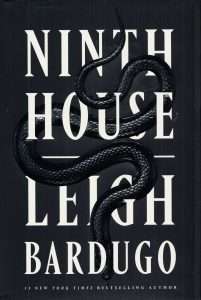 Ninth House is set in and around Yale University. Luckily, Bardugo has added a map showing the locations of the different colleges and various other university buildings to help us get our bearings. The ‘ninth house’ of the title refers to a magical secret society called Lethe House whose role is to monitor the behaviours of the other occult secret societies at Yale, ‘the ancient eight.’ Hence why Lethe is the ‘ninth house’. Lethe House’s unlikely newest recruit is our main character Galaxy ‘Alex’ Stern. Unlike most people she is tasked with keeping an eye on, Alex is not from privilege or exceptionally academic. She’s had a harrowing upbringing and possesses an innate arcane ability that makes her valuable to Lethe, even if said ability has haunted her for most of her life.
Ninth House is set in and around Yale University. Luckily, Bardugo has added a map showing the locations of the different colleges and various other university buildings to help us get our bearings. The ‘ninth house’ of the title refers to a magical secret society called Lethe House whose role is to monitor the behaviours of the other occult secret societies at Yale, ‘the ancient eight.’ Hence why Lethe is the ‘ninth house’. Lethe House’s unlikely newest recruit is our main character Galaxy ‘Alex’ Stern. Unlike most people she is tasked with keeping an eye on, Alex is not from privilege or exceptionally academic. She’s had a harrowing upbringing and possesses an innate arcane ability that makes her valuable to Lethe, even if said ability has haunted her for most of her life.
There is a split timeline to the narrative structure of Ninth House, which eventually converges. Alex’s chapters focus on the present, with her role of supervising the other societies and her slightly slapdash investigation of the murder of a local woman, which she believes has more to it than a domestic dispute getting out of hand. There are also the chapters of Darlington, the Virgil to Alex’s Dante, which take place slightly earlier, and the timelines eventually converge. It was not immediately clear to me that this was happening, so if you do pick up Ninth House, the key to the ‘when’ you are in the story is under each chapter number, where it gives a season. The jumping around did feel a bit jarring at first, but a split narrative was essential for the world-building of Ninth House. Darlington’s character is the more experienced member of Lethe House, and it is through his training of Alex we both learn the history and roles of the other houses and how the magic of this world works. The first part of Ninth House did have a lot of information in a short time, but unless readers already possess knowledge of both classical history and the geography of New Haven, it needed to be there.
Bardugo goes quite dark in the content of Ninth House. Some of this is dark humour that I found appealing, like the idea that Jodie Foster and Anderson Cooper are alumni of the same magical secret society or that one of the houses rigged a presidential election. But there is also a heck of a lot of violence. In an early chapter, there is a gruesome magical ritual involving vivisection. The murder Alex Stern investigates is brutal. Magically supercharged marijuana is one thing, but a magical date rape drug is quite another. In Ninth House, Bardugo unflinchingly shows two opposite ends of society’s spectrum. The harsh realities of Alex’s earlier life with drug use and a seedy criminal underworld juxtapose the abuses of power by the privileged few who are part of the top tier. I have a feeling people may jump into Ninth House if they recognise Bardugo’s name and not be prepared for how dark it is, and it needs to be said that this is not a gateway into the adult fantasy shelves.
However, Ninth House is a well-written dark fantasy. The academic elements and setting were appealing, and I found the magical structure of the different houses interesting. I am glad this is the start of a series and will certainly be picking in the next instalment, Hell Bent, which is out now from Gollancz. 4/5
Read Ninth House by Leigh BardugoThe post REVIEW: Ninth House by Leigh Bardugo appeared first on Grimdark Magazine.
April 11, 2023
An Interview WIth Emily Tesh
Emily Tesh, World Fantasy Award Winner for her Greenhollow Duology, sat down with Grimdark Magazine and discussed her newest novel, Some Desperate Glory. The story follows Kyr, one of her generation’s best warriors, and the choices she is forced to make. It is “a thrillingly told queer space opera about the wreckage of war, the family you find, and who you must become when every choice is stripped from you.”
 Emily was kind enough to answer questions about this novel, her writing, and much more.
Emily was kind enough to answer questions about this novel, her writing, and much more.
[GdM] What is Some Desperate Glory about?
Some Desperate Glory is a story about a young woman who discovers everything she believes in is a lie. It’s about propaganda, radicalisation, deprogramming, and transformation. It imagines a world where humanity went to war against the alien threat and lost. Our protagonist, Valkyr, has grown up as part of the last resistance – or so she thinks. She has trained since childhood to avenge the murder of the Earth; but the people in power on Gaea Station, where she grew up, have other uses for her.
[GdM] What was the impetus of Some Desperate Glory, and how did it develop over time? Did you write it in the last few politically tumultuous years?
SDG is, among other things, a book about a culture so completely unable to accept that they have no right to rule the universe that they cut themselves off from the wider galaxy in order to become ever more inward-looking and obsessed with what they believe is a noble and glorious past. I am English. Frankly, I worried I was getting too close to clanging Brexit allegory, but so far not many people seem to have noticed. And then it’s a story about the ways in which authoritarian populism allows for a certain kind of man—and it is almost always a man—to claim power and use it for his own selfish satisfaction, through a combination of personal charisma and the valorisation of violence. This too is something you can see happening all around the world at the moment, if you follow the news. And it’s a story about how incredibly easy it is to manipulate and lie, to take advantage of very natural human desires—the hunger to belong somewhere, to do good in the world, and to be loved and respected—and use them to radicalize and then exploit people for your own goals. If you want to see this one happening in real time, look on the Internet.
The world worries me. I have read in recent years some beautiful utopian visions of what the future could be, and instead of comforting me, they made me more worried. It is possible to take progress for granted. 1920s Berlin was, for early 20th century Europe, a pretty good place to be a queer person. It’s been said often that dystopian fiction is about the present, not the future. SDG is a book that extrapolates—I hope logically, and without undue alarmism—from things that are already happening.
[GdM] Who is Kyr?
Kyr is the worst protagonist I could think of. She thinks she’s a leader, when in fact she’s a bully. She thinks she’s a hero, when in fact she’s a terrorist. She is desperate to be good, and she causes devastation wherever she goes. I didn’t want to write a story without hope in it. Kyr is capable of change, and she does change. But her journey is not an easy one.
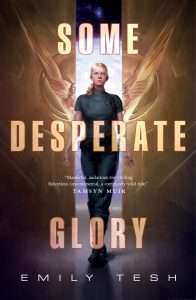 [GdM] Who was the most challenging character to write?
[GdM] Who was the most challenging character to write?
It depends on what you mean by challenge! On a technical level, I cursed every scene where Kyr is with her squadron on Gaea Station, but that’s only because blocking group scenes is hard work in prose fiction – things that would take a single establishing shot in a TV show take two pages of writing to explain, and then you have to cut it all out again because it spoils the pace of the scene.
On the level of putting thought into it, the biggest challenge was the alien character, Yiso. They are a complex person with their own story which Kyr does not really understand or appreciate until the last third of the book. I did not want them to come across as simply a human being in an alien costume; they needed to be alien in their mannerisms, motivations, choices. But not completely alien, because Kyr’s slow realisation of Yiso’s undeniable personhood is key to her journey. In many ways their life story parallels Kyr’s, and insofar as there is a romance at all in this story, it lies in the unspoken, undefined relationship that develops between Kyr and Yiso.
On top of that, I was very aware of the trope—the trap—of the alien as nonbinary character. The culture Kyr grows up in is horrifically transphobic, and Yiso is the only member of the core cast of the story who is outside the gender binary. I did not want that choice to feel thoughtless or ill-considered to nonbinary readers.
[GdM] How did you approach writing an alien culture? Did you draw on any inspirations?
Honestly, I think alien culture hardly appears in this book. Although the idea of an alien threat is constantly present, there are very few non-human characters, and we never visit a non-human world. Ultimately the story is about human relationships and human power. I am a story-first writer, and so the two substantial alien characters—Yiso and their progenitor Leru—were developed largely in terms of their role in the story: what would be most effective, and most interesting, in challenging Kyr’s understanding of the universe?
[GdM] Silver in the Wood is based on the Green Man’s mythos. Kyr’s name, as well as Cleo, call back to famous characters in history. Do you enjoy reading myths and find them to be a source of inspiration?
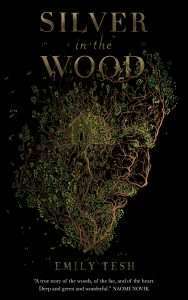 I have a degree in Classics and I have spent many years teaching Latin, Greek, and ancient history. SDG more than anything else I have written draws heavily on my academic background. Particularly in my thoughts was the ancient city-state of Sparta. If you have only come across Sparta via popular depictions, you might not realise what a strange society it was. For example, the movie 300—which tells the story of the Spartan last stand against the Persian invasion of Greece at Thermopylae—presents them on their own terms, as defenders of freedom, and does not mention that the attacking Persian Empire is actually a historical example of a fairly liberal and religiously tolerant style of despotism, while the defending Spartans were the elite aristocrats of a militarised imperial ethnostate which enslaved fellow Greeks and practised a primitive form of eugenics. In ancient Sparta, newborn children were inspected by state officials, and those considered sickly or weak were exposed in the wilderness to die.
I have a degree in Classics and I have spent many years teaching Latin, Greek, and ancient history. SDG more than anything else I have written draws heavily on my academic background. Particularly in my thoughts was the ancient city-state of Sparta. If you have only come across Sparta via popular depictions, you might not realise what a strange society it was. For example, the movie 300—which tells the story of the Spartan last stand against the Persian invasion of Greece at Thermopylae—presents them on their own terms, as defenders of freedom, and does not mention that the attacking Persian Empire is actually a historical example of a fairly liberal and religiously tolerant style of despotism, while the defending Spartans were the elite aristocrats of a militarised imperial ethnostate which enslaved fellow Greeks and practised a primitive form of eugenics. In ancient Sparta, newborn children were inspected by state officials, and those considered sickly or weak were exposed in the wilderness to die.
One element of Spartan society which fascinated ancient commentators was the state education system—non-existent in other Greek states—which they called agoge, cattle-raising. This system took young Spartiate boys and put them through a punishing regime of physical and moral education, all ultimately aimed at producing perfect soldiers. In doing so, they sought to break down the loyalty to the oikos—home and family—and replace it with perfect loyalty to the polis, the city, which was to say your fellow citizen-soldiers and the rulers who commanded you all in battle. Adult Spartan men were expected to visit their wives in the middle of the night, sneaking in and out of the house like criminals.
Sparta needed these perfect soldiers because it was a state caught in a perpetual war. The city’s wealth and power rested on the incident early in her history when she enslaved the entire population of the neighbouring city of of Messene. The Spartiates could afford to be professional soldiers because they had an enslaved nation doing the hard labour of subsistence farming for them; and they needed to be soldiers, because the enslaved nation might rebel at any time (and often did—eventually successfully.) They called their slaves Helots – captives – and ritually declared war against them every year. All the Ancient Greek states were slave-holding societies, of course, but only in Sparta was slavery so explicitly racialised.
I borrowed many elements of this for SDG: the perpetual, inescapable war that demands perfect soldiers; the determination to diminish and weaken any human relationship that does not serve the requirements of the state; the obsession with physical strength, expressed through population politics; and above all the essential insecurity of a regime which is fundamentally shaped by fear of rebellion and a hunger for control. The nice thing about writing science fiction is that one can assume at least some of the characters know about Earth’s history too. The education system on Gaea Station is called the agoge. The station’s leaders know exactly what they are trying to do to the young people in their society.
[GdM] More than any book I have read in years, Some Desperate Glory constantly begs readers and challenges their beliefs about these characters. Is the binary of good and evil a real thing with these characters? Or are we all shades of gray? Was this the idea of the story from the start?
I do think there is no such thing as a good person. We are all products of chance and circumstance and environment. I find this comforting, personally: chances, circumstances, and environments can change, so perhaps people can change too. Perhaps they can become better. That is the hope I wanted to explore in Kyr’s story.
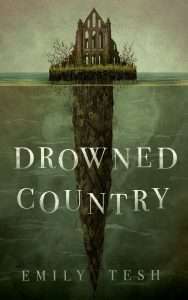 [GdM] While very different in story content, your novels, Some Desperate Glory, Silver in the Wood, and Drowned Country, have a similar overall feel to me as a reader. Look closer. The expression “still waters runs deep” comes to mind. Is the prevailing theme of characters having fathoms of depth something you gravitate towards as a writer?
[GdM] While very different in story content, your novels, Some Desperate Glory, Silver in the Wood, and Drowned Country, have a similar overall feel to me as a reader. Look closer. The expression “still waters runs deep” comes to mind. Is the prevailing theme of characters having fathoms of depth something you gravitate towards as a writer?
I enjoy character work. I think it’s one of the few places where a novel has a real advantage over a film or TV show; you can do deep dives into individual perspectives and motivations in prose narrative that you really can’t do on a screen. This works in reverse too, of course: few writers can hope to achieve the emotional impact that a perfect confluence of audio and visual can create. Anyway, I always write for character, and I usually read for character too.
[GdM] Family dynamics, in its many forms, found or otherwise, come into play in the novel. What was it like writing the tension between the family members or the love? Did you have to step away from the computer and take a breather at any scene?
The protagonist witnesses the suicide of someone dear to her at a key moment in the book. The scene seemed to write itself. I set down the laptop and stared into the middle distance for a long time when it was done.
[GdM] What is next?
I am incapable of sticking to one subgenre. I love the broad sweep of speculative fiction and I want to play with all of it. So I went from tender fantasy romance to dark space opera and now I am going from dark space opera to something much lighter and funnier, back in the realm of fantasy, with wizards and demons and competent career-focused thirtysomethings making good choices. I just wrote a book about a teenager who is repeatedly failed by every single adult she trusted, and it made me want to write the opposite – a fantasy story where no one lets the teenagers anywhere near the burden or the agony of saving the world. Imagine: what if the grown-ups behaved like grown-ups?
Read Some Desperate Glory by Emily TeshThe post An Interview WIth Emily Tesh appeared first on Grimdark Magazine.
Exclusive Cover Reveal: Buzzard’s Bowl by John Palladino
Today we have a special treat for Grimdark Magazine readers: an exclusive cover reveal for Buzzard’s Bowl by John Palladino, the second book in his Tragedy of Cedain series and the follow-up to his grimdark debut, The Trials of Ashmount. Our complete review of the first book can be found here.
Buzzard’s Bowl is the name of Cedain’s gladiator arena, which becomes a major focus in the second book of Palladino’s series. Astute readers will recognize this cover scene from one of the final chapters in The Trials of Ashmount. The plot of Buzzard’s Bowl picks right up from there. According to Palladino, “With the events and action ramping up a lot more in Buzzard’s Bowl, I wanted a more active scene to convey the excitement of the book – really show readers things are about to get interesting.”
The cover art was designed by Dusan Markovic, a graduate of the University of Art in Belgrade who specializes in epic fantasy, sci-fi, and horror genres.
Buzzard’s Bowl will be released on June 1, 2023.
ABOUT THE BOOK:
Cedain continues to collapse.
Ashmount’s destruction shatters the Magicai while the culprits responsible continue sabotaging the world. All the while, the next season of Buzzard’s Bowl begins and Edelbrock, in his constant fight for survival, desires a vengeance he can only find in the arena.
Seradal and Villic find themselves in the middle of a war between Remeria and the Camel Clans, and may end up on opposing sides, while the threat of Calrym looms over all of them.
At the behest of the woman he loves, Demri finds himself thrown into the Elkavich, a not-so-secret order of Magicai who are intent upon fixing the world.
Ashen, a former urchin rescued by a noble with selfish aspirations, works to dismantle the nobility of Calrym.
Death is assured to all who walk the world, the only unknown is when they will perish.
Read Buzzard’s Bowl by John Palladino
The post Exclusive Cover Reveal: Buzzard’s Bowl by John Palladino appeared first on Grimdark Magazine.
April 10, 2023
REVIEW: The Judas Blossom by Stephen Aryan
The Judas Blossom is an ambitious, majestic and brutal historical fantasy read that impresses throughout. The novel skilfully covers an era, areas, and cultures that are not typical with fantasy novels or historical retellings.
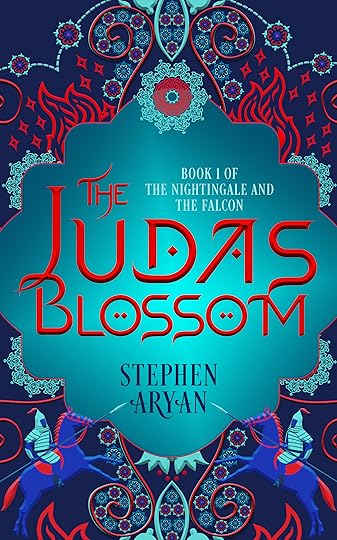 Set in the 13th century, we follow four main point of view perspectives: Hulagu (a warlord), Kokochin (one of his many wives), Temujin (a son he is ashamed of), and Kaivon (a Persian General). All of these characters are major influences on whether the Mongol empire’s plans to encompass the whole world come to fruition or are derailed. Honestly, there is not a subpar viewpoint in The Judas Blossom. Each individual presents their agendas, ideals, weaknesses, and plans, so the drama and stakes are significantly heightened as the novel progresses. I felt engaged and active as a reader, becoming quite smug seeing events and problems certain players were not privy to. In addition, it was a rewarding experience predicting how affairs could play out, with the many webs of influence and deceit in play.
Set in the 13th century, we follow four main point of view perspectives: Hulagu (a warlord), Kokochin (one of his many wives), Temujin (a son he is ashamed of), and Kaivon (a Persian General). All of these characters are major influences on whether the Mongol empire’s plans to encompass the whole world come to fruition or are derailed. Honestly, there is not a subpar viewpoint in The Judas Blossom. Each individual presents their agendas, ideals, weaknesses, and plans, so the drama and stakes are significantly heightened as the novel progresses. I felt engaged and active as a reader, becoming quite smug seeing events and problems certain players were not privy to. In addition, it was a rewarding experience predicting how affairs could play out, with the many webs of influence and deceit in play.
My advanced review copy of The Judas Blossom was approximately 450 pages long and was brimming with excellent action scenes, sieges, confrontations, barbed verbal exchanges, political intrigue, deception, and cleverness. It is often a violent and unforgiving tale, especially when viewing the action that surrounds Hulagu. There are assassins, political factions, secret societies, and a magic scheme similar to R.R. Virdi’s The First Binding. As The Judas Blossom is the first in a series, we learn about how the magic works as the users figure it out themselves, with the true potential and possibilities more likely to appear in the follow-up entries. The magic seems intriguing though and I look forward to witnessing the capabilities further down the line in this epic story.
I picked up The Judas Blossom knowing little about the historical period that it presents. I have no doubt that this is a well-researched and carefully crafted project, that I envisage will delight historians and aficionados who focus on this time period. A couple of nuggets from history such as mentions of Genghis Khan and Kublai Khan made me smile when I acknowledged them and I fell down the Google rabbit hole a couple of times, intrigued to see if certain members of Aryan’s dramatis personae are based on fact or are fictional.
As a work of fiction though, The Judas Blossom is a riveting tale, set in a dynamic world that is equally beautiful and terrifying. It is gripping, the characters are great and there are no filler chapters (which is surprising for epic fantasy and especially the first books in a series). Also, the novel ends in a compelling manner and this has guaranteed that I will read the next release as soon as I can.
I have very little criticism regarding my reading experience. If I had to say something along those lines, occasionally the flow of some passages seemed a little awkward, perhaps ending abruptly where the rhythm didn’t quite resonate with me. Even with that considered, The Judas Blossom is an excellent first entry into an exciting new epic fantasy series. The characters, action scenes, political intrigue, and trickery present here will make many grimdark readers extremely happy. – 8.5/10
Review copy from Angry Robot Books and Stephen Aryan in exchange for an honest review.
Read The Judas Blossom by Stephen AryanThe post REVIEW: The Judas Blossom by Stephen Aryan appeared first on Grimdark Magazine.
April 9, 2023
REVIEW: The Gurkha and the Lord of Tuesday by Saad Z. Hossain
If one were to describe The Gurkha and the Lord of Tuesday, perhaps a way of doing so would be to call it a fish-out-of-water story, sprinkled with a certain irreverent humor that has become Saad Z. Hossain’s hallmark, except that the fish out of water is in fact, a world-conquering djinn awoken from a long imprisonment spanning millennia.
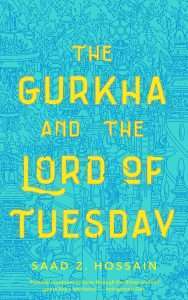 Like its preceding work Cyber Mage, The Gurkha and the Lord of Tuesday is set within a post-apocalyptic Earth where humans secrete nanotech to create suitable climes enabling them to live. But instead of the urban centers of Bangladesh, it’s the remote mountains of Nepal where Melek Ahmar, the Lord of Tuesday finds himself, along with the Gurkha Bhan Gurung, the knife-wielding Vergil to his Dante.
Like its preceding work Cyber Mage, The Gurkha and the Lord of Tuesday is set within a post-apocalyptic Earth where humans secrete nanotech to create suitable climes enabling them to live. But instead of the urban centers of Bangladesh, it’s the remote mountains of Nepal where Melek Ahmar, the Lord of Tuesday finds himself, along with the Gurkha Bhan Gurung, the knife-wielding Vergil to his Dante.
It’s an incongruous, but remarkably compelling character duo—Melek Ahmar’s sardonic observations about the new world he finds himself in, mixed with Gurung’s bland statements, peppered with a barely concealed thirst for violence that alarms even the Lord of Tuesday whose ultimate goal is just to have a good time, form some remarkable moments of grim hilarity.
“We cannot brook this kind of dishonor.”
“Look, I mean, I appreciate it, but really, no need to go out of your way . . .”
“There are other ways to skin a cat,” Gurung said. “A king you are, noble lord of Tuesday, and a kingdom you shall have, this I have sworn, when you took me into your service.”
“Eh? You did? I did? I mean, did I take you into service? I don’t exactly recall . . .”
“I have sworn!”
“Ahem, yes, of course, if you’ve sworn.” Melek Ahmar looked helplessly at ReGi for support, and only got a roll of her goth-black eyes. That was the problem with djinn. They never stepped up. “Irrevocable blood oath, was it?”
“Is there any other kind?”
Speaking of incongruity, playing off contradictions is a recurring theme when it comes to The Gurkha and the Lord of Tuesday. A futuristic, science fiction setting meets djinn existing outside known natural laws. Nearby Kathmandu has become a utopia, a karmic-based society ran under the AI aptly-named Karma, where its citizens want for nothing, yet crave meaning and purpose (perhaps exemplified best by another character Hamilcar Pande, the ‘Sheriff’ of Kathmandu), and the very concept of a perfect utopia ruled by an AI is contradicted by the existence of Kathmandu’s elite, and how they’ve corralled resources to rise up the karmic ranks.
While the flavor of South Asian cyberpunk doesn’t quite percolate as thickly in The Gurkha and the Lord of Tuesday compared to its predecessor, it’s not entirely lacking; there’s a momo place where Kathmandu’s residents go to for their authentic, non-machine printed dumpling needs. There’s an awkward conversation between Hamilcar and an uncle of his love interest about marriage, something all-too-familiar to those of Asian descent, all of which serve to root utopian Kathmandu and the story into a world that feels like it’s genuinely lived in.
All in all, The Gurkha and the Lord of Tuesday has a lot going for it. If you’re into narratives that examine societal issues, interspersed with quirky, memorable characters and incredibly irreverent humor that almost seems to be delivered with a cheeky wink from the author, casually delivering darker concepts and themes without going overboard, this is certainly a book to pick up.
Read The Gurkha and the Lord of Tuesday by Saad Z. HossainThe post REVIEW: The Gurkha and the Lord of Tuesday by Saad Z. Hossain appeared first on Grimdark Magazine.
April 8, 2023
REVIEW: You Know Her by Meagan Jennett
Meagan Jennett’s You Know Her is a gem of a debut. A tense, psychological thriller that makes you root for the murderer rather than for the victims or those chasing her, it is smart and unique – and rather unsettling. This is the sort of story that you can’t put down, that makes you question your own morality. I don’t often read non-speculative crime, and few manage to capture my heart fully. This did. I am convinced I’ll be thinking and talking about You Know Her for a long time to come. I have been raving about this book to anyone who would listen ever since I finished it, and I can’t wait for Sophie to capture reader’s hearts and imaginations on release.
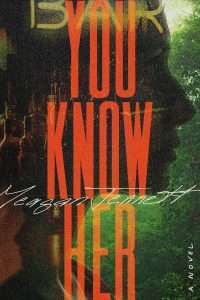 It is rare that a thriller sticks with you not because of plot and pacing, but because of its characters and atmosphere. And You Know Her does so brilliantly. In her debut, Meagan Jennett creates a cast that in turn captivates you, scares you and charms you. As you read more, you get to know the actors in this particular drama, and as you begin to care for them, you need to know how their story goes. There is one particular moment, about halfway through the book – if you read it, you’ll know exactly what I mean – that had me yelling out loud at the book because it was just so brilliantly done, such a great moment for the characters that just made sense with who they are.
It is rare that a thriller sticks with you not because of plot and pacing, but because of its characters and atmosphere. And You Know Her does so brilliantly. In her debut, Meagan Jennett creates a cast that in turn captivates you, scares you and charms you. As you read more, you get to know the actors in this particular drama, and as you begin to care for them, you need to know how their story goes. There is one particular moment, about halfway through the book – if you read it, you’ll know exactly what I mean – that had me yelling out loud at the book because it was just so brilliantly done, such a great moment for the characters that just made sense with who they are.
That isn’t to say that the writing and pacing isn’t immaculate – because it is. You Know Her is all the better for it. Evoking a thick Southern Gothic atmosphere and making sure the tension never dips helps the novel go from strength to strength. This is a novel about feminine rage, at its centre, about being a woman in an industry where women are often considered commodities and Sophie is done. Hit on too many times. Groped too many times. Meagan Jennett’s clean prose helps bring the sentiments across without making You Know Her read like a polemic, but still resonate with a whole generation of readers who know. We may not have been bartenders, we may not have murdered, but we’ve certainly been Sophie in other ways. This is a novel for all of us – a thriller about what it would be like to follow those darkest urges and thoughts when we just need a break from society. And it’s a damn good one, well written, impeccably paced and dripping with Southern Gothic atmosphere.
Read You Know Her by Meagan JennettThe post REVIEW: You Know Her by Meagan Jennett appeared first on Grimdark Magazine.
REVIEW: You Know Her by Megan Jennett
Megan Jennett’s You Know Her is a gem of a debut. A tense, psychological thriller that makes you root for the murderer rather than for the victims or those chasing her, it is smart and unique – and rather unsettling. This is the sort of story that you can’t put down, that makes you question your own morality. I don’t often read non-speculative crime, and few manage to capture my heart fully. This did. I am convinced I’ll be thinking and talking about You Know Her for a long time to come. I have been raving about this book to anyone who would listen ever since I finished it, and I can’t wait for Sophie to capture reader’s hearts and imaginations on release.
 It is rare that a thriller sticks with you not because of plot and pacing, but because of its characters and atmosphere. And You Know Her does so brilliantly. In her debut, Megan Jennett creates a cast that in turn captivates you, scares you and charms you. As you read more, you get to know the actors in this particular drama, and as you begin to care for them, you need to know how their story goes. There is one particular moment, about halfway through the book – if you read it, you’ll know exactly what I mean – that had me yelling out loud at the book because it was just so brilliantly done, such a great moment for the characters that just made sense with who they are.
It is rare that a thriller sticks with you not because of plot and pacing, but because of its characters and atmosphere. And You Know Her does so brilliantly. In her debut, Megan Jennett creates a cast that in turn captivates you, scares you and charms you. As you read more, you get to know the actors in this particular drama, and as you begin to care for them, you need to know how their story goes. There is one particular moment, about halfway through the book – if you read it, you’ll know exactly what I mean – that had me yelling out loud at the book because it was just so brilliantly done, such a great moment for the characters that just made sense with who they are.
That isn’t to say that the writing and pacing isn’t immaculate – because it is. You Know Her is all the better for it. Evoking a thick Southern Gothic atmosphere and making sure the tension never dips helps the novel go from strength to strength. This is a novel about feminine rage, at its centre, about being a woman in an industry where women are often considered commodities and Sophie is done. Hit on too many times. Groped too many times. Megan Jennett’s clean prose helps bring the sentiments across without making You Know Her read like a polemic, but still resonate with a whole generation of readers who know. We may not have been bartenders, we may not have murdered, but we’ve certainly been Sophie in other ways. This is a novel for all of us – a thriller about what it would be like to follow those darkest urges and thoughts when we just need a break from society. And it’s a damn good one, well written, impeccably paced and dripping with Southern Gothic atmosphere.
Read You Know Her by Megan JennettThe post REVIEW: You Know Her by Megan Jennett appeared first on Grimdark Magazine.
April 7, 2023
REVIEW: The Liar’s Knot by M.A. Carrick
If the defining term for The Masks of Mirrors by M.A. Carrick is ‘subterfuge’, then its sequel, The Liar’s Knot can summarily be defined by ‘found family’—specifically, the main characters and their bond between each other.
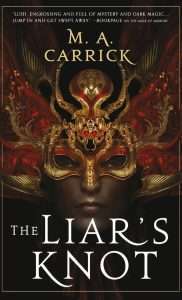 Readers of the first book will by now, be more than aware of the gorgeous, swashbuckling style that the Rook & Rose trilogy promises; the deftness with which subterfuge and plots are overlaid on top of each other, along with its keen attention to fashion make a triumphant return. Perhaps more notably, the plot continues to intrigue even as the events of the first book find a firm conclusion, with Ondrakja and her zlyzen, and Mettore Indestor out of the picture.
Readers of the first book will by now, be more than aware of the gorgeous, swashbuckling style that the Rook & Rose trilogy promises; the deftness with which subterfuge and plots are overlaid on top of each other, along with its keen attention to fashion make a triumphant return. Perhaps more notably, the plot continues to intrigue even as the events of the first book find a firm conclusion, with Ondrakja and her zlyzen, and Mettore Indestor out of the picture.
But as in any epic fantasy, there’s always another threat, another thread to unravel, and this becomes the main premise of The Liar’s Knot. Who placed a cursed upon House Traementis? Is Vargo, whose actions betrayed Renata previously a foe, or an ally?
“Nothing about Nadežra is clean, from Lower Bank to Upper. But this is and always has been a city of masks.”
This is where The Liar’s Knot shines—where the previous book excels at the interplay of secrets building up upon each other and being juggled in a gradually dizzying loop, here the narrative is at its best unravelling those secrets and letting them tumble into a glorious, messy pile.
M.A. Carrick have discovered the perfect balance to strike with revealing a character’s secrets, and it’s a refreshing moment of realism; sometimes people confide in each other, especially after undergoing life-or-death situations, and they find comfort in that! Neither does the plot’s tension go away, because it simply shifts perspective, from between characters to the adversities at hand.
Indeed, that very confrontation of lies, of revealing the truth makes The Liar’s Knot a fitting name. In the setting, a knot can also refer to a gang of thieves, and so the title becomes something of a wordplay, for Renata, Grey and Vargo are all liars in and of themselves, and it’s only through showing their faces—and thus, creating that knot—can they face the threats that loom over them.
And of course, there’s more than just character moments to look forward to in The Liar’s Knot. The Rook continues their fantastical crusade behind the inscrutable hood, Vargo continues to be intriguing in the ways only those bearing a villain’s edge often do, there’s more detailed descriptions of clothing and the city the characters inhabit, and even the arcane mysteries of a cult to delve into.
To reiterate, on top of the riot of color and style that the first book brought, The Liar’s Knot provides much, much more character drama and development; it’s very much a book that focuses on making you root tenfold for characters you’ve come to like in the first, and asks you to love them, even as they come to love each other. If you’re one for excellent character writing, I cannot recommend this more, for I certainly enjoyed it a great deal more than the first.
Read The Liar’s Knot by M.A. CarrickThe post REVIEW: The Liar’s Knot by M.A. Carrick appeared first on Grimdark Magazine.
April 6, 2023
Liveplay Review: Bookshops of Arkham
Critical Role created an entirely new sort of entertainment on the internet when it realized that people would pay decent money, at least in terms of Twitch stream revenue, as well as devote hours of their lives in order to watch other people play Dungeons and Dragons. It has since become something of a cottage industry to have talented actors and actresses roleplay online. Indeed, the ascension of Vox Machina from online game to animated series shows just how far this can go.
But as Doctor Krieger on Archer says, “Now I’m into something… darker.” First, I enjoyed the World of Darkness channel produced LA By Night that did multiple seasons of my second favorite tabletop RPG AKA Vampire: The Masquerade. However, my secret hope was that they would apply the Critical Role production values to Call of Cthulhu. Which, as you might guess, is my all-time favorite tabletop game.
Mark Meer AKA Commander Shepard the Male Edition has decided to kick off a campaign hosted by Chaosium. This is not their first live play of Chaosium but is the highest production values and devotion to the costume as well as acting element for the game. Each of the actors/players are very keen on their roles from the very moment they come on screen with all four players for a tale of horror set in Arkham, Massachusetts.
The premise for Call of Cthulhu, if you’re unfamiliar, is it is a tabletop game based on the writings of HP Lovecraft. The game somewhat zig-zags between genuine cosmic horror where everyone dies or goes insane as versus Pulpy adventure where you can Indiana Jones your way to stopping the cultists from destroying the world for another week.
This particular campaign, which is not an adaptation of any of Chaosium’s many modules but a wholly original work, is about how a charity auction is being conducted for a local orphanage. Three bookshops are donating expensive and rare manuscripts to be bid on at auction. The bidders that evening include parapsychologist Hazel Berkovitch (Saige Ryan), bibliophile teenager Neil Black (Carlos Luna), quirky spiritualist Judith Van Horne (Lucia Versprille), and gangster Mickey Sykes (Patrick Logan).
Things go horribly wrong very quickly and the four find themselves attempting to recover three magical books dating back to the Salem Witch Trials. The protagonists start off pretty goofy and somewhat silly, like in a Critical Role game, but turn into a serious horror story as the books warp their sense of reality as well as morality. The protagonists do a lot of morally questionable things and it’s fascinating to see how they compromise their beliefs in hopes of survival or defeat the enemies.
It’s not quite a horror game, more dark fantasy, but I really enjoyed the four and a half episodes of Bookshops of Arkham. I say four and a half because due to technical episodes, one of the episodes was lost and the producers decided to instead do a summary told as a dark and creepy story. The ending was quite powerful and I strongly enjoyed it from beginning to end. Sadly, I don’t think they’re going to have a sequel.
Lovecraft fans will find this a bit too fantastical in places with the use of extra-dimensional sites and perhaps a bit too much melodrama as well as joking but that’s only if you think all adaptations should be True Detective. I came to bond with all of the protagonists and really wanted them to continue the campaign onward to do the kind of international long-running campaign you saw in Masks of Nyarlathotep or Shadows of Yog-Sothoth.
My favorite of the characters was definitely Hazel but all of them made a strong impressions on me. I regret we didn’t more “down time” to get to know the characters but the Call of Cthulhu premise always seems to imply that the protagonists will go insane or be killed before that happened. Like Seth Skorkowsky, I don’t believe this should be the case and think that’s a bad playstyle. Mind you, this is more, “investigate the anomoly” than “get eaten by tentacles.”
Liveplays of roleplaying games aren’t going to be for everyone but like improv theater, they are enjoyable for quite a few of the audience. If you’re willing to invest enough time for basically a miniseries, I think there’s a lot to appreciate from this. I hope they do more of these and I would love to see an adaptation of Chasoium’s more famous work. Mark Meer is a fantastic Keeper and really brings the setting to life.
It is available on Chasosium’ Youtube channel.
The post Liveplay Review: Bookshops of Arkham appeared first on Grimdark Magazine.





